The global vehicle interior air quality monitoring technology market is forecasted to grow from USD 1.3 billion in 2025 to USD 2.6 billion by 2035, registering a CAGR of 7.2% during the forecast period.
Quick Stats for Vehicle Interior Air Quality Monitoring Technology Market
Market Value (2025): USD 1.3 billion
Forecast Value (2035): USD 2.6 billion
Global CAGR: 7.2%
Leading Segment in 2025: Hardware (~65% share)
Key Growth Region: Asia Pacific (China, India, Japan), Europe (United Kingdom, Germany)
Key Players: DENSO, Robert Bosch, Honeywell International Inc, MAHLE, Emerson, Sensirion, LG, SGS, Eberspächer Group, Mechanical Simulation
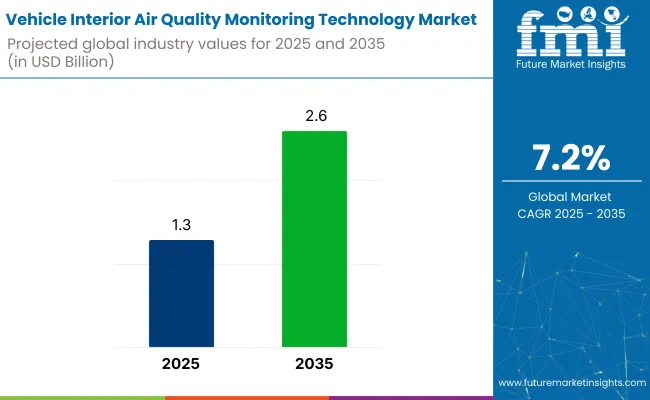
The growing concerns regarding indoor air quality and health implications are encouraging the adoption of air filtration and monitoring systems in cars. Consumer awareness about air quality and health-related issues is further accelerating industry adoption. Increased demand for electric vehicles (EVs) and autonomous vehicles (AVs) is also contributing to the industry expansion.
Advanced sensor technologies and smart vehicles are being utilized to create sophisticated real-time air quality monitoring systems for vehicle interiors. These systems are designed to detect pollutants, allergens, and volatile organic compounds (VOCs) in the cabin air. “Advances in sensor technology and smart vehicles mean that how and when we use our cars is changing. Just as air pollution and indoor air quality have become a requirement for healthy homes, car cabin air quality is now also under scrutiny,” said Dr. John McKeon, CEO of Allergy Standards Limited (ASL).
The vehicle interior air quality monitoring technology industry forms a small but growing share across its broader parent segments. Within the automotive cabin air quality sensors industry, it holds a substantial 30-35% share, as core monitoring modules integrate with filtration and ventilation systems. In the wider automotive environmental sensors industry, its contribution is approximately 10-12%, competing with sensors for temperature, humidity, and ambient light.
Within the vehicle HVAC and air filtration systems segment, air quality monitoring accounts for 8-10%, supporting adaptive filtration and climate control. Its share in the smart vehicle electronics category stands at 5-7%, driven by rising demand for health-focused connected features. Across the expansive automotive electronics industry, its presence remains typically under 1% but is gaining strategic importance.
Vehicle Interior Air Quality Monitoring Technology Market Analyzed by Top Investment Segments
The vehicle interior air quality monitoring technology market is experiencing strong growth, driven by investments in hardware, infrared-based detection, and cabin air quality monitoring, fueled by concerns over air quality and regulations.
Hardware Is Expected to Lead the Market
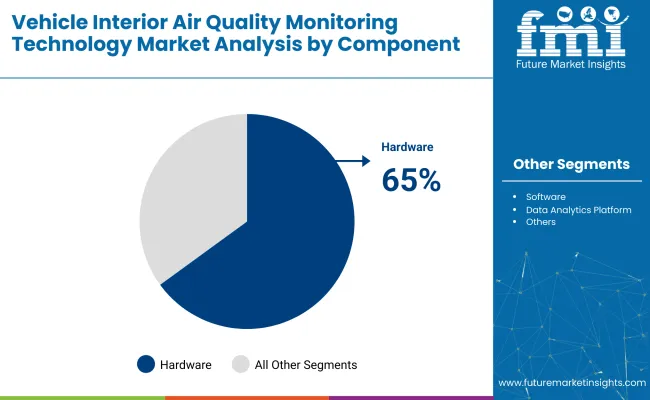
The hardware component is expected to dominate the market, accounting for 65% of the share by 2025. This dominance is driven by the increasing demand for sensors, controllers, and other components that are essential for real-time monitoring and management of cabin air quality.
Companies such as Honeywell and Bosch are leading the charge in providing high-quality sensors that measure particulate matter, carbon dioxide, and volatile organic compounds. These hardware components are integrated into vehicle air conditioning systems, offering real-time analysis of indoor air conditions, improving cabin comfort, and promoting passenger health.
Particulate and gas sensors are being integrated into OEM-standard air filtration systems.
Multi-functional boards are being customized for compact installations in mid-segment vehicles.
Automotive-grade chipsets are being certified for air quality processing applications.
Infrared-Based Detection will Dominate the Technology Segment.
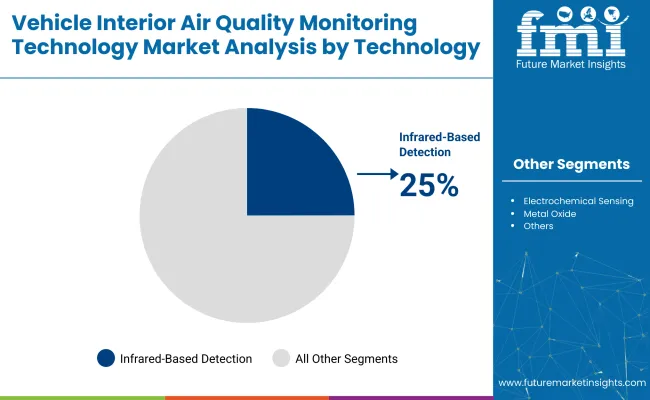
Infrared-based detection technology is projected to capture 25% share by 2025. This technology offers a non-invasive, efficient method for detecting and monitoring harmful gases such as carbon dioxide and nitrogen dioxide within the vehicle cabin.
Companies like Osram and Raytheon are enhancing infrared-based detection systems with greater sensitivity and accuracy, enabling better detection of particulate matter and other contaminants in the air. As vehicle manufacturers and consumers increasingly prioritize health-conscious solutions, infrared-based detection is becoming an essential component in vehicle interior air quality systems, contributing to safer driving environments.
Infrared-based dual-wavelength sensors are being adopted for CO₂ calibration accuracy.
Miniaturized NDIR sensors are being installed in luxury and electric vehicle lines.
Smart HVAC systems are being optimized using IR data feedback for pollutant removal.
Passenger Cars Are Expected to Lead the Vehicle Type Segment
Passenger cars are expected to dominate the vehicle type segment, holding a 55% share in 2025. The growing focus on cabin air quality for personal vehicles is being driven by rising awareness of health risks associated with air pollution and increasing regulatory requirements for air quality control systems.
Leading automotive manufacturers, including Toyota and Ford, are incorporating advanced air quality monitoring systems into their vehicles to meet consumer demand for cleaner, healthier driving environments. This trend is further bolstered by the integration of smart technologies and eco-friendly materials that enhance cabin air circulation and filtration, driving adoption in passenger vehicles.
HEPA-filter-supported sensors are being embedded in next-gen electric vehicles.
Personalized zone-based monitoring is being tested in premium car segments.
App-linked cabin diagnostics are being offered by connected vehicle manufacturers.
Cabin Air Quality Monitoring to Lead the Application Segment
Cabin air quality monitoring is projected to capture a 35% share in 2025. This application focuses on detecting and managing pollutants such as carbon monoxide, particulate matter, and allergens inside the vehicle cabin. Companies like Denso and Valeo are pioneering technologies that enable real-time air quality monitoring systems, allowing for automatic adjustments to the vehicle’s ventilation system.
This functionality is crucial for maintaining a comfortable and safe environment for passengers, especially in urban areas where air quality is often compromised. As consumer demand for cleaner air in vehicles continues to rise, cabin air quality monitoring is becoming a standard feature in modern vehicles.
Automated fan-speed adjustments are being activated through in-cabin AQI thresholds.
Mobile-connected dashboards are being developed for in-transit air quality reporting.
Cabin monitors with real-time visual AQ indicators are being incorporated in EVs.
Top Vehicle Interior Air Quality Monitoring Technology Market Dynamics
The vehicle interior air quality monitoring market is growing due to increased consumer awareness, stricter regulations, and technological advancements. However, high implementation costs and integration complexities could limit widespread adoption.
Heightened Regulation and Awareness Propel Adoption
Demand for in-cabin air quality solutions is being supported by consumer health priorities and compliance with air pollution legislation. Vehicle manufacturers have been required to install particulate and gas sensors that track cabin pollutants. In markets such as Europe and North America, air quality benchmarks have been mandated, pushing OEMs toward system-wide deployment.
EU in-cabin air quality standards are being applied to passenger car models since 2024.
Vehicle wellness ratings are being influenced by real-time AQI performance.
Integrated AQ monitoring is being prioritized for family and medical-use vehicles.
Cost and Technical Complexity Constrain Broader Rollout
Adoption has been slowed by elevated system costs and compatibility issues with traditional vehicle platforms. High-precision sensors, embedded analytics, and calibration processes have increased unit pricing. Retrofitting legacy models with smart air systems has proven operationally intensive, especially for low-margin manufacturers.
Sensor recalibration requirements are being flagged as a cost driver in OEM testing.
Technical integration with HVAC and BMS is being seen as resource-heavy.
Mid-tier automakers are deferring rollout in favor of lower-cost filter-based alternatives.
Analyzing Top Countries Manufacturing, Deploying, and Advancing Vehicle Interior Air Quality Monitoring Technology
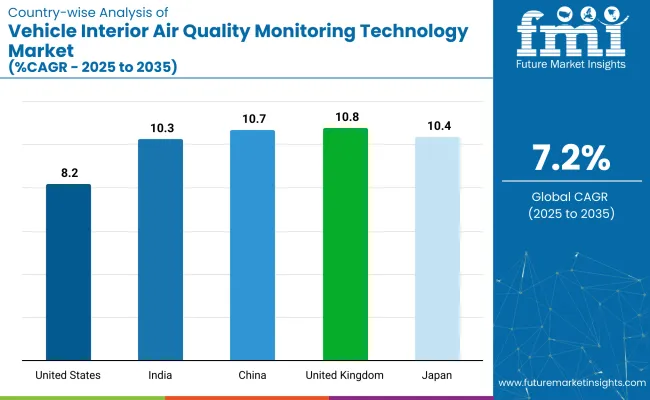
Countries
CAGR (2025 to 2035)
United States
8.2%
United Kingdom
10.8%
China
10.7%
India
10.3%
Japan
10.4%
During 2025 to 2035, an average CAGR of 9.8% is projected to be recorded by OECD participants in the vehicle interior air-quality monitoring technology industry. A rise of 10.8% is expected to be registered by the United Kingdom, enabled by tightened in-cabin VOC directives and wellness-centric trim features. An increase of 10.4% is forecast to be observed in Japan, supported by sensor integration within hybrid and battery-electric platforms, whereas 8.3% growth is anticipated to be experienced by the United States, aided by premium SUV refresh cycles.
BRICS economies are projected to post a mean of 10.5%; China’s 10.8% trajectory is being propelled by electric-vehicle production quotas that require active filtration, and India’s 10.3% outlook is being driven by passenger-car emission norms and heightened cabin-hygiene awareness. A global expansion rate of 7.2% is set to be observed, reflecting regulatory impetus and occupant-well-being priorities.
The report covers detailed analysis of 40+ countries and the top five countries have been shared as a reference.
Analysis of Vehicle Interior Air Quality Monitoring Technology Market in the United States
The United States vehicle interior air quality monitoring technology market is expected to grow at a CAGR of 8.2% through 2035. Growth is being supported by increasing consumer demand for better air quality and health-conscious living. Leading automotive companies such as Ford, General Motors, and Tesla are integrating advanced air quality sensors and filtration systems into vehicles.
Government regulations and industry standards promoting cleaner environments are encouraging innovation. Rising awareness about the effects of air pollution on health and the growing focus on electric vehicles further drive industry demand. Continuous advancements in air quality sensors and real-time monitoring systems support industry expansion.
AI-enhanced AQI dashboards are being added in premium SUV segments.
Standardization of in-cabin sensor placement is being evaluated by NHTSA.
Retail financing options for in-car health tech add-ons are being explored.
Demand Forecast for Vehicle Interior Air Quality Monitoring Technology Market in the United Kingdom
The United Kingdom vehicle interior air quality monitoring technology market is projected to grow at a CAGR of 10.8% through 2035. Growth is being supported by rising consumer awareness about air quality and its impact on health. Major automotive manufacturers such as Jaguar Land Rover, BMW, and Volvo are focusing on the integration of advanced air purification and monitoring technologies in vehicles.
Increasing government focus on emission reduction and efforts drive product development. Innovations in smart air quality sensors and filtration systems enhance performance. Moreover, regulatory frameworks ensuring healthier driving environments contribute to the industry’s growth in the UK.
NHS-linked guidelines on indoor transport air quality are being referenced.
Allergy-based air filtration ratings are being adopted by leading dealerships.
Tax incentives for “health-ready” vehicles are being evaluated post to 2025.
Growth Analysis of Vehicle Interior Air Quality Monitoring Technology Market in China
The vehicle interior air quality monitoring technology market in China is expected to grow at a CAGR of 10.7% through 2035. Expansion is being driven by rapid industrialization, increasing automotive sales, and rising health concerns related to air pollution. Leading automotive brands like BYD, Geely, and SAIC Motor are investing in product innovation and expanding their portfolios.
Government regulations on pet food safety and nutritional standards enhance consumer confidence. Distribution channels including veterinary clinics and e-commerce platforms are being strengthened. Awareness of pet health conditions like obesity, renal disorders, and allergies is increasing demand. Product development focusing on ingredient quality supports industry growth.
Smart cockpit ecosystems integrating AQ monitors are being scaled across EV fleets.
OEM-led AQ data sharing with municipal health networks is being tested.
Domestic sensor start-ups are being funded via provincial innovation grants.
Future Outlook for Vehicle Interior Air Quality Monitoring Technology Market in India
The vehicle interior air quality monitoring technology market in China is anticipated to grow at a CAGR of 10.3% through 2035. Growth is driven by increasing consumer awareness, growing urbanization, and a rising middle class. Automotive companies such as Tata Motors, Mahindra & Mahindra, and Hyundai India are incorporating air quality monitoring systems in vehicles to cater to health-conscious consumers.
Increased demand for electric vehicles and stringent environmental regulations are driving the adoption of advanced air quality monitoring technologies. Innovations in air purification systems and sensors ensure the quality of cabin air, while government support for automotive technologies accelerates industry growth.
Smart cabin health kits are being bundled with EV sales in metro cities.
Real-time air quality alerts via mobile apps are being synced with vehicle sensors.
Public awareness campaigns on cabin air safety are being backed by MoEFCC.
Vehicle Interior Air Quality Monitoring Technology Market Growth Outlook in Japan
The vehicle interior air quality monitoring technology market in Japan is projected to grow at a CAGR of 10.4% through 2035. Growth is supported by the country’s emphasis on advanced radar technologies and strategic defense initiatives. Key players such as Mitsubishi Electric, NEC Corporation, and the Japan Aerospace Exploration Agency (JAXA) are actively developing sophisticated space radar systems.
Investments in satellite-based radar for environmental monitoring, defense surveillance, and disaster management are prioritized. Technological innovation, strong government support, and international collaborations further propel industry growth.
Sensor accuracy verification under ISO 16000 is being institutionalized.
Scent-neutralization tech using ionization is being embedded in kei cars.
Cabin AQI analytics are being included in vehicle-to-home IoT platforms.
Leading Companies in Vehicle Interior Air Quality Monitoring Technology Market
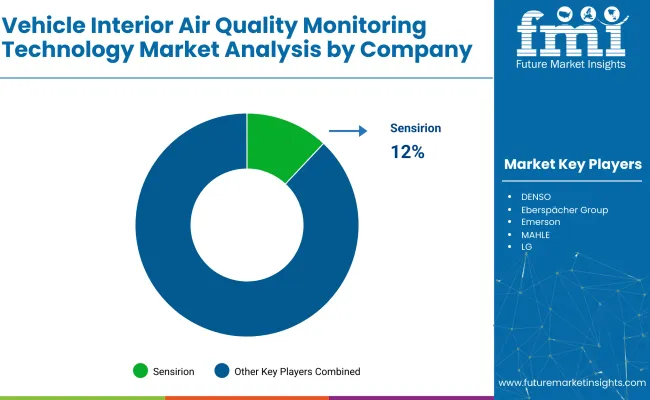
The market is led by established suppliers such as DENSO, Honeywell International, and Bosch, known for their advanced air quality sensors and integration within HVAC systems. These companies maintain a strong presence across automotive OEM platforms, focusing on in-cabin wellness and regulatory compliance. Mid-tier contributors like Emerson and MAHLE support the industry with modular monitoring solutions that align with evolving emissions standards.
Niche-focused firms such as SGS address specific use cases, including air-quality compliance testing and certification. Rising consumer health concerns, stricter in-cabin VOC limits, and growing urban air pollution are compelling OEMs to adopt advanced sensor systems. This shift is accelerating the integration of real-time air monitoring in both passenger and commercial vehicles.
Recent Vehicle Interior Air Quality Monitoring Technology Industry News
In May 2025, Groove Technologies launched the Qik-FIT™ Universal Cabin Air Filter System, designed for easy installation and high efficiency, fitting 80% of cabin air filter sales. This patent-protected system addresses the aftermarket need for air quality improvement.
In August 2024, Renesas Electronics introduced the RRH62000 all-in-one sensor module, capable of monitoring harmful airborne contaminants like particulates and VOCs, providing real-time cabin air quality measurement.
Key Players in Vehicle Interior Air Quality Monitoring Technology Market
DENSO
Eberspächer Group
Emerson
Honeywell International Inc
LG
MAHLE
Mechanical Simulation
Robert Bosch
Sensirion
SGS
Research Coverage and Scope Summary
Report Attributes
Details
Current Total Industry Size (2025)
USD 1.3 billion
Projected Industry Size (2035)
USD 2.6 billion
CAGR (2025 to 2035)
7.2%
Base Year for Estimation
2024
Historical Period
2020 to 2024
Projections Period
2025 to 2035
Quantitative Units
USD billion for value and million units,
Components Analyzed (Segment 1)
Software: Data analytics platforms; Real-time monitoring dashboards; Others Hardware: Gas sensors; Humidity & temperature sensors; Odor sensors; Others Service: Installation & integration; Calibration & maintenance
Technologies Analyzed (Segment 2)
Infrared-based detection; Electrochemical sensing; Photoionization detection; Metal oxide semiconductors; Others
Vehicle Types Covered (Segment 3)
Passenger cars: Sedan; Hatchback; SUV Commercial vehicles: Light commercial vehicle; Heavy commercial vehicle; Buses & coaches
Applications Covered (Segment 4)
Cabin air quality monitoring; HVAC system integration; Real-time driver & passenger health alerts; Fleet health management; Others
Regions Covered
North America, Europe, Asia-Pacific, Latin America, Middle East, and Africa
Countries Covered
United States; Canada; United Kingdom; Germany; France; Italy; Spain; Belgium; Sweden; China; India; Japan; Australia; Singapore; South Korea; Southeast Asia; Brazil; Mexico; Argentina; South Africa; Saudi Arabia; UAE
Key Players
DENSO; Eberspächer Group; Emerson; Honeywell International Inc; LG; MAHLE; Mechanical Simulation; Robert Bosch; Sensirion; SGS
Additional Attributes
Dollar sales by component (hardware vs software vs services); Growth of cabin air quality monitoring systems in electric vehicles; Integration with autonomous driving technologies; OEM vs aftermarket adoption trends; Regulatory push for improved in-cabin air quality systems
By Component:
The industry is segmented by component into software (data analytics platforms, real-time monitoring dashboards, and others), hardware (gas sensors, humidity & temperature sensors, odor sensors, and others), and service (installation & integration, calibration & maintenance).
By Technology:
The industry includes infrared-based detection, electrochemical sensing, photoionization detection, metal oxide semiconductors, and others.
By Vehicle:
The industry is segmented by vehicle type into passenger cars (sedan, hatchback, SUV), commercial vehicles (light commercial vehicle, heavy commercial vehicle, buses & coaches).
By Application:
The industry includes cabin air quality monitoring, HVAC system integration, real-time driver & passenger health alerts, fleet health management, and others.
By Region:
The industry covers North America, Europe, Asia Pacific, Latin America, and Middle East & Africa.
